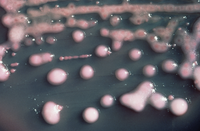
Photo from wikipedia
The prevalence of Carbapenem-resistant Klebsiella pneumoniae (CRKP) is currently increasing worldwide, prompting WHO to classify it as an urgent public health threat. CRKP is considered a difficult to treat organism… Click to show full abstract
The prevalence of Carbapenem-resistant Klebsiella pneumoniae (CRKP) is currently increasing worldwide, prompting WHO to classify it as an urgent public health threat. CRKP is considered a difficult to treat organism owing to limited therapeutic options. In this study, a total of 24 CRKP clinical isolates were randomly collected from Salmaniya Medical Complex, Bahrain. Bacterial identification and antibiotic susceptibility testing were performed, on MALDI-TOF and VITEK-2 compact, respectively. The isolates were screened for carbapenem resistance markers (bla NDM, bla OXA-23, bla OXA-48 and bla OXA-51) and plasmid-mediated quinolone resistance genes (qnrA, qnrB, and qnrS) by monoplex PCR. On the other hand, only colistin-resistant isolates (n=12) were screened for MCR-1, MCR-2 and MCR-3 genes by monoplex PCR. Moreover, the Genetic environment of bla NDM, integrons analysis, and molecular characterization of plasmids was also performed. Antibiotic susceptibility revealed that all the isolates (100%) were resistant to ceftolozane/tazobactam, piperacillin/tazobactam, 96% resistant to ceftazidime, trimethoprim/sulfamethoxazole, 92% resistant to meropenem, gentamicin and cefepime, 88% resistant to ciprofloxacin, imipenem, and 37% resistant to amikacin. Ceftazidime/avibactam showed the least resistance (12%). 75% (n=12/16) were resistant to colistin and 44% (n=7/16) showed intermediate susceptibility to tigecycline. The detection of resistant determinants showed that the majority (95.8%) of CRKP harbored bla NDM-1, followed by bla OXA-48 (91.6%) bla OXA-51 (45.8%), and bla OXA-23 (41.6%). Sequencing of the bla NDM amplicons revealed the presence of bla NDM-1. Alarmingly, 100% of isolates showed the presence of qnrS. These predominant genes were distributed in various combinations wherein the majority were bla NDM-1 + bla OXA-51+ qnrS + bla OXA-48 (n =10, 41.7%), bla NDM-1 + bla OXA-23+ qnrS + bla OXA-48 (n=8, 33.3%), among others. In conclusion, the resistance rate to most antibiotics is very high in our region, including colistin and tigecycline, and the genetic environment of CRKP is complex with the carriage of multiple resistance markers. Resistance to ceftazidime/avibactam is uncommon and hence can be used as a valuable option for empirical therapy. Molecular data on resistance markers and the genetic environment of CRKP is lacking from this geographical region; this would be the first report addressing the subject matter. Surveillance and strict infection control strategies should be reinforced in clinical settings to curb the emergence and spread of such isolates.
Journal Title: Frontiers in Cellular and Infection Microbiology
Year Published: 2022
Link to full text (if available)
Share on Social Media: Sign Up to like & get
recommendations!